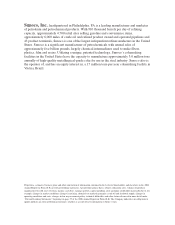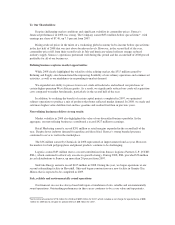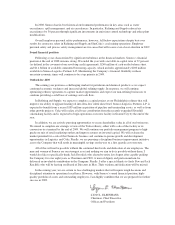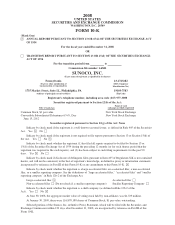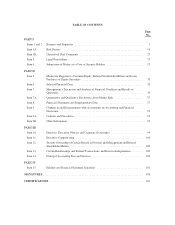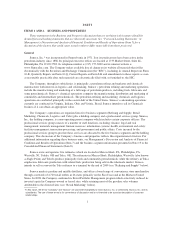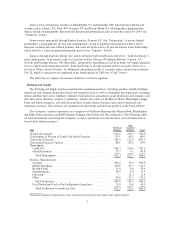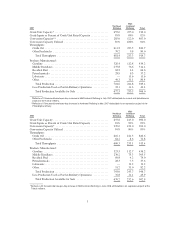Sunoco 2008 Annual Report Download - page 12
Download and view the complete annual report
Please find page 12 of the 2008 Sunoco annual report below. You can navigate through the pages in the report by either clicking on the pages listed below, or by using the keyword search tool below to find specific information within the annual report.
Sunoco meets all of its crude oil requirements through purchases from third parties. There has been an
ample supply of crude oil available to meet worldwide refining needs, and Sunoco has been able to supply its
refineries with the proper mix and quality of crude oils without material disruption. Most of the crude oil
processed at Sunoco’s refineries is light-sweet crude oil. The Company believes that ample supplies of light-
sweet crude oil will continue to be available. The Company also processes limited amounts of discounted high-
acid sweet crude oils in its Northeast refineries. During 2008, 2007 and 2006, approximately 71, 62 and
63 thousand barrels per day, respectively, of such crude oils were processed.
The Philadelphia, Marcus Hook and Eagle Point refineries process crude oils supplied from foreign sources.
The Toledo refinery processes domestic and Canadian crude oils as well as crude oils supplied from other foreign
sources. The Tulsa refinery processes domestic and foreign-sourced crude oils. The foreign crude oil processed at
the Company’s Northeast refineries is delivered utilizing ocean-going tankers and coastal distribution tankers and
barges that are owned and operated by third parties. Approximately 20 percent of the Company’s ocean-going
tanker marine transportation requirements pertaining to its Northeast Refining crude supply are met through time
charters. Time charter leases for the various marine transportation vessels typically require a fixed-price payment
or a fixed-price minimum and a variable component based on spot-market rates and generally contain terms of
between three to seven years with renewal and sub-lease options. The cost of the remaining marine transportation
requirements reflects spot-market rates.
Approximately 25 percent of Sunoco’s crude oil supply during 2008 came from Nigeria. Some of the crude
oil producing areas of this West African country have experienced political and ethnic violence as well as labor
disruptions in recent years, which has resulted in the shutdown of a small portion of total Nigerian crude oil
production during that time. The lost crude oil production in Nigeria did not have a material impact on Sunoco’s
operations. During the second half of 2008, Sunoco reduced the amount of Nigerian-sourced crude oil run at its
refineries by approximately 250 thousand barrels per day versus historical levels and replaced this crude oil with
sweet crude oil alternatives that were available at a discount to the premium Nigerian grades. The Company
believes these other sources of light-sweet crude oil will continue to be available in the event it elects to continue
to diversify its crude oil slate for economic reasons or in the event it is unable to obtain crude oil from Nigeria in
the future.
The following table sets forth information concerning the source of the Company’s crude oil purchases (in
thousands of barrels daily):
2008 2007 2006
Crude Oil Source:
West Africa ................................................ 434.6 530.2 562.1
Domestic ................................................... 139.3 125.8 128.9
Canada .................................................... 75.0 89.7 76.7
Central Asia ................................................ 71.8 37.3 24.1
North Sea .................................................. 7.6 7.5 8.5
South and Central America .................................... 31.8 35.8 27.7
Australia ................................................... 5.4 — —
“Lubes-Extracted” Gasoil/Naphtha Intermediate Feedstock ........... 12.8 10.1 10.0
778.3 836.4 838.0
4


